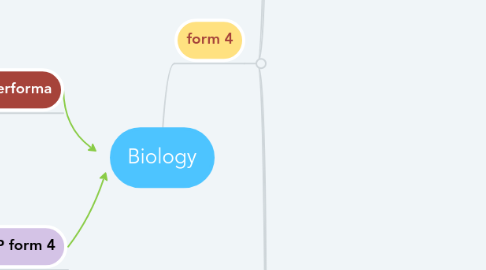
1. performa
2. HSP form 4
3. form 4
3.1. introducing biology
3.1.1. introduction to biology
3.1.1.1. understanding the study of biology
3.1.1.2. applying scientific investigation
3.1.2. invitation to biology
3.1.2.1. the unity of live
3.1.2.2. levels of life
3.1.2.3. diversity of life
3.1.2.4. the process of science
3.1.2.5. discovery science
3.1.2.6. hypothesis driven science
3.1.2.7. the culture of science
3.1.2.8. science, technology and society
3.2. investigating the cell as a basic unit of living things
3.2.1. cell structure and cell organisation
3.2.1.1. understanding cell structure and function
3.2.1.1.1. structure and function of eukaryotic cell
3.2.1.1.2. nucleus
3.2.1.1.3. ribosome
3.2.1.1.4. reticulum
3.2.1.1.5. golgi apparatus
3.2.1.1.6. lysosomes
3.2.1.1.7. vacuoles
3.2.1.1.8. chloroplast
3.2.1.1.9. mitochondria
3.2.1.1.10. cytoskeleton
3.2.1.2. understanding cell organisation
3.2.1.2.1. levels of organization
3.2.1.3. appreciating the uniqueness of the cell
3.2.2. movement of substances across the plasma membrane
3.2.2.1. analysing the of movement of substances across the plasma membrane
3.2.2.2. understanding the movement of substances across the plasma membrane in everyday life
3.2.2.3. appreciating the movement of substance across the plasma membrane
3.2.3. eukaryotic cell
3.2.3.1. cell under the microscope
3.2.3.2. the two major categories of cells
3.2.3.3. a panoramic view of eukaryotic cells
3.2.3.4. the plasma membrane
3.2.3.5. a fluid mosaic of lipids and proteins
3.2.4. chemical composition of the cell
3.2.4.1. understanding the chemical composition of the cell
3.2.4.2. understanding carbohydrates
3.2.4.3. understanding lipids
3.2.4.4. understanding protein
3.2.4.5. understanding enzymes
3.2.4.6. realising the importance of the chemical composition in cells
3.2.5. molecule of life
3.2.5.1. organic molecule
3.2.5.2. the carbon atoms
3.2.5.3. the carbon skeleton and functional group
3.2.5.4. carbohydrates
3.2.5.5. lipids
3.2.5.6. proteins
3.2.5.7. nucleic acid
3.2.5.8. the organic molecular of cell
3.2.6. chemical basic
3.2.6.1. the nature of matter
3.2.6.2. elements and compunds
3.2.6.3. atomic structure
3.2.6.4. isotope
3.2.6.5. number of electron in an atom
3.2.6.6. types of chemical bonds and molecules
3.2.6.7. chemical reactions
3.2.6.8. water's important to life
3.2.6.9. the structure of water
3.2.6.10. properties of water, acid and bases
3.2.7. cell division
3.2.7.1. understanding mitosis
3.2.7.2. understanding meiosis
3.2.7.3. appreciating the movement of chromosomes during mitosis and meiosis.
3.2.8. introduction to molecule biology
3.2.8.1. DNA and RNA structure and function
3.2.8.2. DNA replication
3.2.8.3. gene expression
3.2.8.4. central dogma
3.2.8.5. transcription
3.2.8.6. translation
3.2.8.7. mutations
3.2.8.8. DNA technology
3.2.8.9. recombinant DNA technology
3.2.8.10. polymerase chain reaction
3.2.8.11. genetic engineering applications
3.2.8.12. gene regulation
3.3. investigating the physology of living things
3.3.1. nutrition
3.3.1.1. understanding types of nutrition
3.3.1.2. applying the concept of balanced diet
3.3.1.3. understanding malnutrition
3.3.1.4. analysing food digestion
3.3.1.5. understanding the processes of absorption and assimilation of digested food
3.3.1.6. understanding the formation of faeces and defection
3.3.1.7. evaluating eating habits
3.3.1.8. realising the importance of a healthy digestive system
3.3.1.9. understanding the importance of macronutrients and micronutriences in plant
3.3.1.10. understanding photosynthesis
3.3.1.11. understanding the mechanism of photosynthesis
3.3.1.12. synthesising factors affecting photosynthesis
3.3.1.13. practising a caring attitude towards plants
3.3.1.14. understanding the technology used in food production
3.3.1.15. evaluating the technological development in food processing
3.3.2. introduction to photosynthesis
3.3.2.1. the basic of photosynthesis
3.3.2.2. chloroplast
3.3.2.3. light reactions
3.3.2.4. converting solar energy to chemical energy
3.3.2.5. light reactions
3.3.2.6. converting solar energy to chemical energy
3.3.2.7. photosynthesis pigments
3.3.2.8. the electron pathway of the light reactions
3.3.2.9. organization of the thylakoid membrane
3.3.2.10. calvin cycle
3.3.2.11. fixation of carbon dioxide
3.3.2.12. reduction of carbon dioxide
3.3.2.13. regeneration of RuBp
3.3.3. respiration
3.3.3.1. understanding the respiratory process in energy production
3.3.3.2. analysis the respiratory structures and breathing mechanisms in human and animal
3.3.3.3. understanding the concept of gaseous exchange across the respiratory surfaces and transport of gases in human
3.3.3.4. understanding the regulation the regulatory mechanism in respiration
3.3.3.5. realising the importance of maintaning a healthy respiratory system
3.3.3.6. understanding respiration in plants
3.3.4. chemical energy
3.3.4.1. ATP: energy for cell
3.3.4.2. metabolic pathways and enzymes
3.3.4.3. cell transport
3.3.4.4. cellular respiration
3.3.4.5. glucose respiration
3.3.4.6. metabolic pathway of cellular respiration
3.3.4.7. outside the mitochondria
3.3.4.8. glycoylysis
3.3.4.9. energy- investment step
3.3.4.10. energy- hervesting step
3.3.4.11. inside the mitochondria
3.3.4.12. the citric acid cycle
3.4. investigating the relationship between living thing and the environment
3.4.1. dynamic ecosystem
3.4.1.1. understanding the abiotic and biotic components of the environment
3.4.1.2. understanding the processes of colonisation and succession in an ecosystem
3.4.1.3. synthesising ideas on population ecology
3.4.1.4. understanding the concept of biodiversity
3.4.1.5. understanding the impact of microorganisms on life
3.4.1.6. appreciating biodiversity
3.4.2. endangered ecosystem
3.4.2.1. evaluating human activities that endanger an ecosystem
3.4.2.2. understanding the greenhouse effect and thinning of the ozone layer
3.4.2.3. realising the important of proper management activities and the ecosystem
